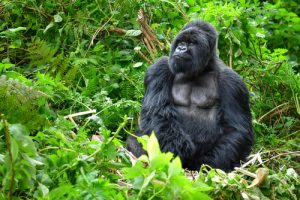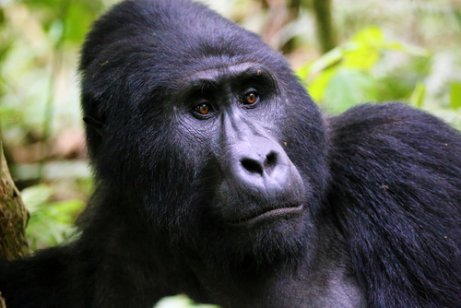Mountain Gorilla, a Unique Primate


Written and verified by the vet Eugenio Fernández Suárez
Although many species deserve everyone’s attention, there are some animals that have a history and relationship with humans that are particularly unique. One of these animals that deserves everyone’s attention is the Mountain Gorilla (Gorilla beringei beringei).
The Mountain Gorilla: Its Origin
In order to see how special the mountain gorilla is, take a look at its classification. The term “gorilla” covers two species: the Western Gorilla, which is broken down into the Lowland and Cross River Gorillas.
On the other hand, there is the Eastern Gorilla, which has two subspecies: The Lowland Gorilla and the Mountain Gorilla. However, in this article, we are going to take a closer look at the Mountain Gorilla.
The Mountain Gorilla is one of the subspecies of the Eastern Gorilla, which only consists of two groups that remain in the wild. One group lives in the mythical Virunga mountains, which were recently featured in a documentary. The other lives in the Bwindi forest in Uganda.
Several skulls of the mountain gorilla were sent to Europe to be used for their classification. Naturalist Carl Akeley convinced King Albert of Belgium to create a national park in the Virunga mountains.
George Schaller conducted in-depth studies about the Mountain Gorilla and was eventually followed by Dian Fossey. Fossey made the species known to the world and dedicated her life to save them from extinction. Unfortunately, her work resulted in her tragic death.
Why is the Mountain Gorilla so unique?
These gorillas have long back tufts of hair much denser than other gorillas. Fossey mentioned in her notes that this primate lives in impenetrable jungles surrounded by thick fog. These jungles have remained unseen by westerners for millennia.
This species, totally isolated, has inbred for thousands of generations, which is detrimental to wild populations. Inbreeding is the spreading of similar genes, which threatens the entire population in regard to disease or changes in the environment.

In addition, inbreeding can lead to genetic diseases or malformations. Dian Fossey mentioned in her notes about the species having deformations, such as six fingers on each hand. This is a clear example of the effects that isolation has on the genes.
The cost of saving the Mountain Gorilla
This species was on the verge of extinction. The conservationist efforts of Dian and other scientists have resulted in the populations doubling in number. Even so, the cost is high. A veterinary team known as the gorilla doctors takes care of the animals constantly.
The fame that helped Fossey gain momentum for the project also led to tourism. This means that the gorillas not only have veterinary care, but they also have many cameras pointing at them.
This helps bring in money for their protection. However, it increases the risk of transmitting human diseases to the gorillas.
Viruses and respiratory diseases have killed many of these gorillas. Therefore, tourists must wear a mask and keep their distance from the animals.

Although this unique way of conserving nature has caused occasional incidents with tourists, the peaceful gorilla rarely feels threatened by the dozens of curious eyes that accompany their guards into the forest.
The legacy of Dian Fossey
At first, when Fossey began studying these animals, she realized they were about to disappear from the face of the planet. Hunting the animals to display them in American and Europe, conflicts with humans, poaching, and habitat loss had severely affected the survival of the mountain gorilla.
What Fossey did was not just to study the species. She also created patrols of guards and dogs to protect them against poachers. Likewise, the patrols would remove any traps from the gorillas’ habitat.
Also, she worked on preserving a greater portion of the gorillas’ habitat and taught the world about the importance of saving these animals.
Many people believe that without the tireless efforts of Dian Fossey, the mountain gorilla would be extinct by now. Today, more than 800 specimens live in the impenetrable jungles of Africa. Hopefully, their population will continue to grow.
Although many species deserve everyone’s attention, there are some animals that have a history and relationship with humans that are particularly unique. One of these animals that deserves everyone’s attention is the Mountain Gorilla (Gorilla beringei beringei).
The Mountain Gorilla: Its Origin
In order to see how special the mountain gorilla is, take a look at its classification. The term “gorilla” covers two species: the Western Gorilla, which is broken down into the Lowland and Cross River Gorillas.
On the other hand, there is the Eastern Gorilla, which has two subspecies: The Lowland Gorilla and the Mountain Gorilla. However, in this article, we are going to take a closer look at the Mountain Gorilla.
The Mountain Gorilla is one of the subspecies of the Eastern Gorilla, which only consists of two groups that remain in the wild. One group lives in the mythical Virunga mountains, which were recently featured in a documentary. The other lives in the Bwindi forest in Uganda.
Several skulls of the mountain gorilla were sent to Europe to be used for their classification. Naturalist Carl Akeley convinced King Albert of Belgium to create a national park in the Virunga mountains.
George Schaller conducted in-depth studies about the Mountain Gorilla and was eventually followed by Dian Fossey. Fossey made the species known to the world and dedicated her life to save them from extinction. Unfortunately, her work resulted in her tragic death.
Why is the Mountain Gorilla so unique?
These gorillas have long back tufts of hair much denser than other gorillas. Fossey mentioned in her notes that this primate lives in impenetrable jungles surrounded by thick fog. These jungles have remained unseen by westerners for millennia.
This species, totally isolated, has inbred for thousands of generations, which is detrimental to wild populations. Inbreeding is the spreading of similar genes, which threatens the entire population in regard to disease or changes in the environment.

In addition, inbreeding can lead to genetic diseases or malformations. Dian Fossey mentioned in her notes about the species having deformations, such as six fingers on each hand. This is a clear example of the effects that isolation has on the genes.
The cost of saving the Mountain Gorilla
This species was on the verge of extinction. The conservationist efforts of Dian and other scientists have resulted in the populations doubling in number. Even so, the cost is high. A veterinary team known as the gorilla doctors takes care of the animals constantly.
The fame that helped Fossey gain momentum for the project also led to tourism. This means that the gorillas not only have veterinary care, but they also have many cameras pointing at them.
This helps bring in money for their protection. However, it increases the risk of transmitting human diseases to the gorillas.
Viruses and respiratory diseases have killed many of these gorillas. Therefore, tourists must wear a mask and keep their distance from the animals.

Although this unique way of conserving nature has caused occasional incidents with tourists, the peaceful gorilla rarely feels threatened by the dozens of curious eyes that accompany their guards into the forest.
The legacy of Dian Fossey
At first, when Fossey began studying these animals, she realized they were about to disappear from the face of the planet. Hunting the animals to display them in American and Europe, conflicts with humans, poaching, and habitat loss had severely affected the survival of the mountain gorilla.
What Fossey did was not just to study the species. She also created patrols of guards and dogs to protect them against poachers. Likewise, the patrols would remove any traps from the gorillas’ habitat.
Also, she worked on preserving a greater portion of the gorillas’ habitat and taught the world about the importance of saving these animals.
Many people believe that without the tireless efforts of Dian Fossey, the mountain gorilla would be extinct by now. Today, more than 800 specimens live in the impenetrable jungles of Africa. Hopefully, their population will continue to grow.
This text is provided for informational purposes only and does not replace consultation with a professional. If in doubt, consult your specialist.







